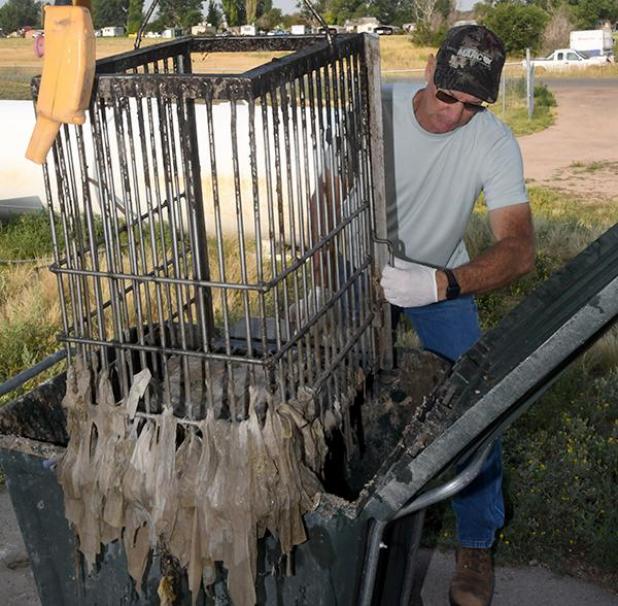
Lennie Fisbeck raises the wastewater screening basket at the wastewater treatment plant Monday morning, Aug. 16. Flushable wet wipes can be seen in the basket, which city workers dispose of when they clean the basket. Most plugs and clogs in Holyoke are due to the flushing of flushable wet wipes, which are not biodegradable. — The Holyoke Enterprise | Johnson Publications
Residents can help wastewater treatment process run more smoothly
Everyone wants to see their city be successful, and it often takes everyone doing their part to achieve that goal.
In the case of making sure Holyoke’s wastewater treatment plant operates efficiently, it’s a question of not doing something that is the main issue.
Lennie Fisbeck, foreman of the city’s water department, said flushable wipes cause problems in wastewater systems like Holyoke’s as well as in the systems of larger cities.
“The products say they’re flushable, but they’re not biodegradable,” he said, adding that they are made to not crumble. “That is really our biggest problem.”
Fisbeck went on to say that toilet paper often dissolves before it reaches the lift station, but most of the plugs in town are often due to flushable wipes.
There is a wastewater screening basket at the lift station at the wastewater treatment plant on County Road 41 that’s meant to catch large items before they can plug the aerators in the ponds. Fisbeck said the basket needs to be cleaned at least once a week — sometimes twice — and there are often flushable wipes clogged in the basket.
Flushable wipes are the most common problem, but city crews have found tin cans, washcloths, small towels and razor blades in the screening basket.
When items plug a pond’s aerator, city workers reverse the motor to try to get the debris out. When this doesn’t work, they have to take a small boat to the aerator and manually remove the obstruction.
Fisbeck noted that they have to unplug aerators at least four times per week, but it has had to be done on a daily basis for the last two weeks.
Flushable wipes cause problems in the city’s lateral sewer lines, main sewer lines and at the lift station, resulting in potential delays in the water treatment process and extra work for city personnel.
Aspects of wastewater treatment work together to be efficient
The wastewater treatment has four lagoons, or ponds, and a lift station that all have a part in treating the city’s sewer water.
After sewer water flows by gravity to the lift station, it is pumped into the first lagoon cell. The first two ponds each have two aerators, so the sewer water is treated with aeration in the first and second ponds. Adding oxygen in the first pond is the primary treatment, and adding it in the second pond is the secondary treatment.
Fisbeck said the aeration process oxygenates the water, which is needed to allow microscopic organisms in the water to break down the organic waste.
The organisms continue to break down the waste in the third pond, which is called the stabilization pond. The water then flows into the fourth pond, which is the storage pond.
At that point, the treated water is used for irrigation at the city’s alfalfa field around the cemetery. In order to disinfect it, the water is treated in a chlorination basin as it’s applied to the alfalfa.
This effluent, or discharge water, is also tested for biological oxygen demand, total suspended solids, pH and E. coli, all of which have parameters that the city must stay within to be in compliance with regulations.
BOD testing indicates the amount of oxygen which bacteria and other microorganisms consume in a water sample to degrade the water contents aerobically. It is an important parameter for the assessment of the degree of pollution that wastewater represents for the environment.
City workers check the pump meter at the lift station every day of the year. State regulations require them to record the number of gallons that flow into the lift station daily, which is the hydraulic loading capacity.
For monthly state testing, city personnel must have an eight-hour composite sample of the influent water that flows into the lift station tested for BOD levels.
Fisbeck said for BOD, the city averages about 300 pounds per day, and the maximum allowed on the city’s permit is 800 pounds per day. In terms of hydraulic load capacity, the city averages about 150,000 gallons per day, and the permit allows a maximum of 300,000.
“We have a backup generator for power outages so this place keeps functioning,” Fisbeck said.
He added that each pond has a detention time, which is the number of days the water is treated in the pond. Fisbeck said this number is arrived at by dividing the volume of a pond by the average amount of daily water flow.
Currently, Fisbeck said water stays about 17 days in the first pond, 17 in the second and 54 in the third, meaning that water spends about 88 days being treated before it arrives in the storage pond.
Fisbeck said there is a thermostat that turns off the aerators when the temperature gets too cold. When the ponds freeze, the aerators can’t run, and this reduces the action the bacteria and other organisms can take on the waste in the water.
He added that this can cause the occasional smell from the ponds when ice begins to melt in January, February and March. He noted that city crews get the aerators running again as soon and as often as they can.
When the aerators aren’t working because of a clog, the water is less oxygenated and the breaking down of organic waste becomes less efficient. Not flushing items that shouldn’t be flushed is a way residents can do their part to make sure the process is efficient.
